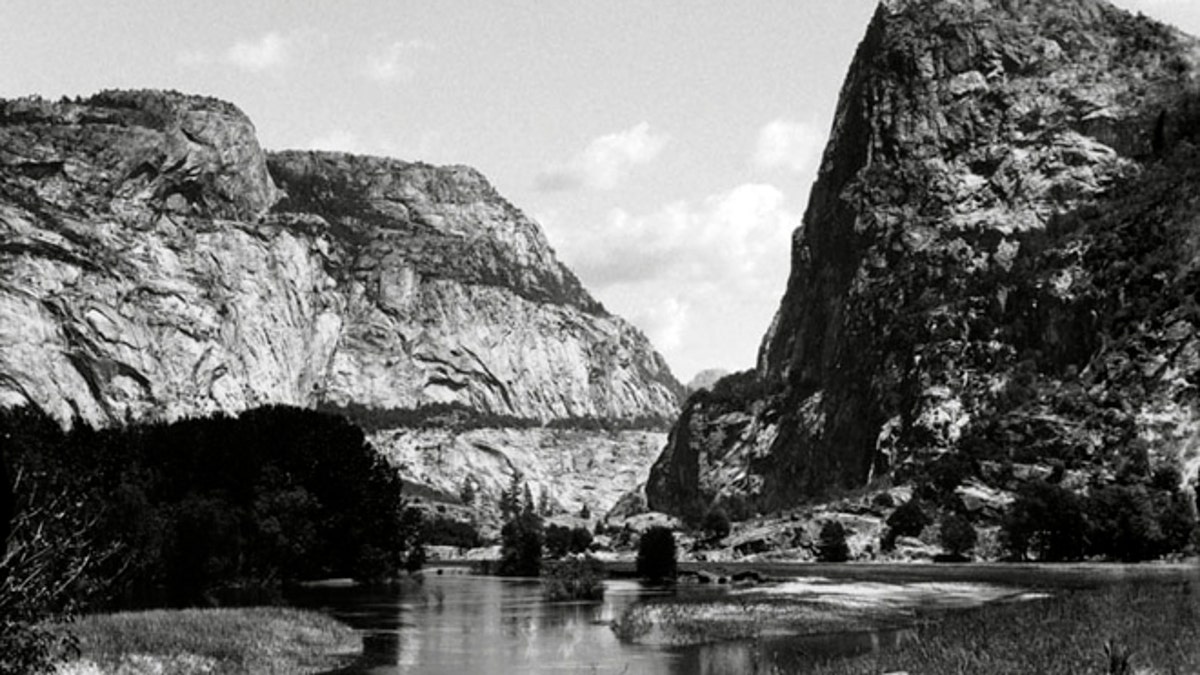
This pre-1913 file photo shows the Hetch Hetchy Valley in Yosemite National Park, Calif. (AP/The Bancroft Library)
YOSEMITE NATIONAL PARK, Calif. – This fall San Franciscans will vote on a local measure with national implications: It could return to the American people a flooded gorge described as the twin of breathtaking Yosemite Valley.
Voters will decide whether they want a plan for draining the 117-billion-gallon Hetch Hetchy reservoir in Yosemite National Park, exposing for the first time in 80 years a glacially carved, granite-ringed valley of towering waterfalls 17 miles north of its more famous geologic sibling.
The November ballot measure asks: Should city officials devise a modern water plan that incorporates recycling and study expansion of other storage reservoirs to make up the loss?
The measure could eventually undo a controversial century-old decision by Congress that created the only reservoir in a national park and slaked the thirst of a city 190 miles away.
The battle over Hetch Hetchy, first waged unsuccessfully by naturalist John Muir, had turned the Sierra Club from an outdoors group into an environmental powerhouse. The fight gained momentum in recent years when unlikely allies joined forces.
On one side are Republican lawmakers and environmentalists, including Ronald Reagan's former interior secretary, who want the dam removed and valley restored. On the other are Democratic San Franciscans, led by Sen. Dianne Feinstein and Rep. Nancy Pelosi, fighting to hold onto the city's famously pure drinking water in a drought-prone state.
"Eventually it will be broadly understood what an abomination a reservoir in a valley like Yosemite Valley really is," Donald Hodel, the former interior chief, told The Associated Press. "I think it will be hard to quell this idea (of restoration). It is like ideas of freedom in a totalitarian regime. Once planted they are impossible to repress forever."
Over the past decade, studies by the state and others have shown it's possible for San Francisco to continue collecting water from the Tuolumne River further downstream.
But the city never seriously has considered giving up its claim to the valley.
"This is a ridiculous idea," Mayor Ed Lee said. "It's a Trojan Horse for those that wish to have our public tricked into believing we have an adequate substitute for the Hetch Hetchy reservoir. We do not. There isn't any."
The gravity-fed system serves 7 percent of California's population, city water officials say. Turbines from its dams generate hydroelectric power for city buildings, streetlights and traffic signals, the airport and the transit system. And two-thirds of the water from the system is sold to neighboring municipalities.
All of this for just $30,000 a year. That was the rent set by Congress when it passed the Raker Act in 1913, giving San Francisco exclusive control and use of the Hetch Hetchy valley, despite opposition by 200 newspapers across the country and after a week of contentious debate.
For the next decade stands of black oaks that had shaded deer and bear along the Tuolumne River through the half-mile-wide valley were removed along with 6 million board feet of lumber used to build the dam. By 1923, water began flooding what once were lush meadows.
In recent years, politicians have argued that San Francisco is getting a bargain and that the rent should be increased. Others have said San Francisco is violating the Raker Act because the city's transmission lines stop 30 miles short of the city and that Pacific Gas & Electric profits by carrying it the rest of the way.
With opposition from then-Mayor Feinstein, Hodel brought the issue back to life in 1987 as a way of alleviating crowds and traffic in Yosemite Valley, which now sees 4 million visitors a year.
Most recently the George W. Bush administration tried funding a feasibility study, but it was quashed politically by Democrats when Pelosi was Speaker of the House.
"San Francisco is known as a progressive city in many ways, especially environmentally. But in water, it's just not the case. We've got a very sweet deal," said Spreck Rosekrans of Restore Hetch Hetchy, who has studied the issue for 20 years. "Restoring the valley would undo the greatest wrong that has ever been done to a national park."
Studies by the federal Bureau of Reclamation, the state Department of Water Resources and others show restoring the valley is technically feasible. The cost estimates range from $3 billion to $10 billion.
"On top of that staggering price tag, replacing the water supply is unrealistic when California already lacks infrastructure to provide enough water for its economy or environment," said Feinstein. "We should move past this debate and focus on real solutions to California's water challenges."
The opposing sides also dispute the impact of reservoir removal. The Hetch Hetchy group says the city would lose 20 percent of its 1.7 billion kilowatt power-generating capacity, roughly the amount of excess production sold at cost to the Modesto and Turlock irrigation districts. The city says it would lose about twice that much, which would cost $41 million.
In addition, utilities officials say water rates would increase by up to $2,777 per household a year and the city would be vulnerable during droughts.
Mayor Lee and others argue that the timing is wrong to spend so much money on a project that ultimately could make Bay Area water deliveries less reliable.
Proponents say passage of the measure in November would give San Francisco a chance to plan for restoration on its own terms. Voters would decide in four years whether to move forward with the plan.
"The opposition to removal is akin to the famous expressions many years ago about relinquishing the Panama Canal: `We stole it fair and square and we should keep it!"' Hodel said.

